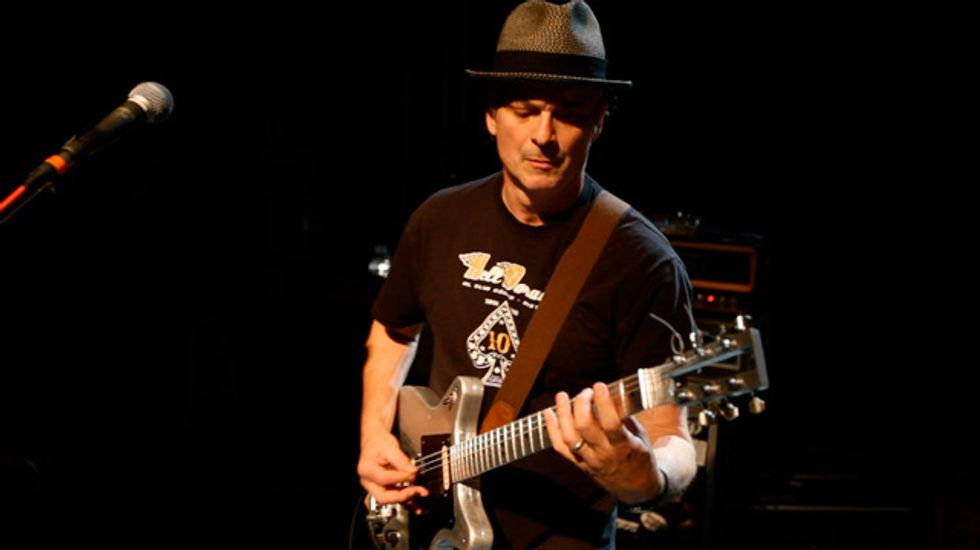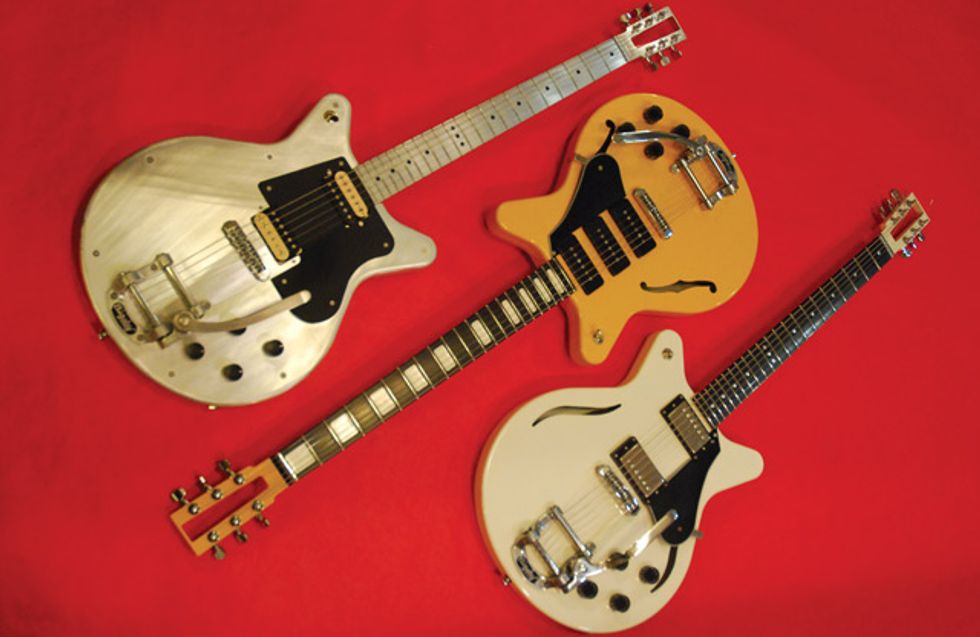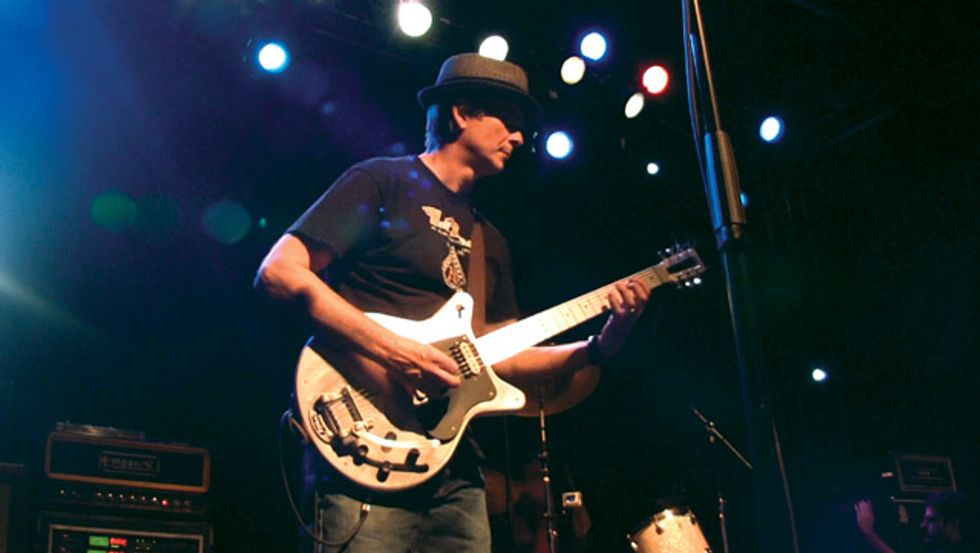Jesus Lizard guitarist Duane Denison talks about the reunion of supergroup Tomahawk, his aluminum electrical guitar company Axes, and why he hates sustain.
Photo by Vincent Forcier
Last Halloween weekend marked only the second time in nearly a decade that alt-rock supergroup Tomahawk— vocalist Mike Patton (Faith No More, Mr. Bungle), guitarist Duane Denison (the Jesus Lizard), bassist Trevor Dunn (Mr. Bungle), and drummer John Stanier (Helmet)—had played a live show together. It was at the annual Voodoo Music + Arts Experience festival in New Orleans, and it was in support of the band’s new January 2013 album, Oddfellows.
If you’re unfamiliar with Tomahawk, the Jesus Lizard, and Denison’s playing with Hank III, Firewater, Silver Jews, and the Legendary Shack Shakers, the main thing you need to know is that he eschews the blues-based mannerisms typical of so much rock music these days. Some of Denison’s fanciest playing is muted—like an evil Andy Summers—and his rhythms and leads intertwine in unique ways that combine his scholarly knowledge of classical guitar with touches of flamenco and reggae to form a minimalist style many have called “jazz punk.”
Denison sketched out each of Tomahawk’s three albums at home on guitar and drum machine before emailing MP3s to his long-distance bandmates. Although he’s always been a tasteful player, Denison has become even more enamored of space since he began writing for Patton’s wild-yet-golden pipes.
“You don’t have to hit people over the head,” he says on Tomahawk’s tour bus before the Voodoo show. “It’s nice to kind of step back and let the vocals take over. If you have a guitar sound like mine that tends to be fairly bright and shrill, ear fatigue sets in pretty quick, and unless you’re a super fan of that kind of thing, you’re gonna tune out after a while.”
Like other musicians incubated in the ’90s Chicago scene that revolved around Touch and Go Records and producer Steve Albini, Denison is also known for his interesting gear. Throughout the Jesus Lizard’s heyday, he played aluminum-necked Travis Bean guitars.
“Kramer also made a primitive aluminum-neck guitar,” he says. “It had fake wood grain crammed in around it and a Phil Petillo [Petillo Precision Fret] fretboard that were just terrible. But even the Travis Beans … I was always fighting them.”
At some point, the “fighting” became tiresome, and Denison was thrilled when Kevin Burkett of Electrical Guitar Company offered to create a custom, all-aluminum guitar for the Jesus Lizard’s 2009 reunion tour. “Kevin knew I’d sold my Travis Beans off,” Denison remembers. “I was in a new phase of playing and went to the Gibson ES-135.”
Denison’s EGC Chessie signature model is a neck-through design with hollowed-out cavities around the wings, where gill-like slits take the place of standard f-holes. Whereas the Travis Beans he was used to playing were neck-heavy, Denison’s EGC models are almost tin-can light. “The newest one is the lightest so far—about 7 pounds,” he beams. “We had to put some ballast in the tail to keep it balanced.”
Duane Denison’s signature Chessie 6-strings from Electrical Guitar Company: The brushed-aluminum axe at upper left features bolts on the front for fast
maintenance, and it and the white version at lower right feature Gibson Burstbucker pickups, while the P-90-equipped yellow model is for Denison’s work
with the Legendary Shack Shakers.
While most EGCs come with single-coils, humbuckers, or P-90s made in house, the Denison Chessie comes with Gibson Burstbucker pickups. At the Voodoo fest, Denison played a white Chessie for much of the show, but EGC also made him a bright yellow Chessie with black trim and traditional f-holes. Created specifically for Denison’s roots rockabilly band, the Legendary Shack Shakers, the yellow Chessie uses P-90s to produce a sound Denison says is “real toothy—just a great vintage sound. I usually avoid P-90s because of the noise and hum. When I was a kid, if the guitar was noisy you’d take tinfoil and shove it into the routing. But when the P-90s are cased in aluminum like this, the whole body is a shield and the P-90s are awesome—silent.”
Of his unfinished Oddfellows-era EGC guitar, Denison says, “It’s a minimalist rock machine.” To enhance its mechanistic look, ECG drilled into the front of the guitar the bolts that normally line the edge of its guitars’ backs. Remove the bolts, and the guitar opens in one piece for repair. Its bare aluminum neck boasts the same width and pitch as a Gibson ES-135. “I can’t think of another guitar that has that combination— the pitch, the feel, plus the scale length, and all while keeping the weight down.”
Asked what inspired his EGC models, Denison says much of their design is owed to the year he spent working for Gibson. “I would do 30 setups a day— bridge, tailpiece, nut, stringing it up, setting the pickups, and adjusting the action.” In the process, says Denison, “I realized Les Pauls rarely have intonation issues. I really came to respect the pitch of the Gibson necks, and the Les Paul as a model of design. So [with my guitar], we put a pitch of three degrees and extended the scale length to 25 inches. If you keep it around 25, you can put heavier strings on and they don’t feel so heavy. The Dunlop .011s I’m using now feel great.”
Tonally, Denison says his guitars have a little more brightness and clarity than a Les Paul. “There’s not as much sustain,” he says, “but that’s by design—the quest for sustain is misguided. I want the notes to fade. I don’t want them to just howl.”
One might imagine that an all-aluminum guitar could sound tinny, but Denison vouches for his Chessies’ versatility. “You get all the highs— but also the lows. It’s pure sounding. You’re not going to get a wood tone,” he admits, “but wood’s overrated. People fetishistically insist on certain types of aged wood—and that does color the sound—but with rock distortion, I defy you to A/B it in a studio and tell me what year the wood was cut and what side of the hill the trees grew on and how much rainfall they had. I think it’s the pickups, the strings, and the amp that make your guitar sound.”
Photo by Vincent Forcier
Speaking of which amps “make” his guitar sound, Denison discloses that he recorded Oddfellows with Fender amps—a recent Super-Sonic and a ’90s Vibro-King— although, live, he’s been using a green-stained, 3-input prototype head from Emperor Cabinets. “It’s a very good-sounding hybrid of a Hiwatt and a Fender Bassman,” Denison explains. “One [input] is more UK sounding, one is more USA sounding, and one is a blend. I use the blend input most often.” He routes the 100-watt, 6L6-powered amp through two Emperor 2x12 cabinets varnished to look like chocolate leather. One cab has Eminence speakers, and the other has Electro-Voice EVM12Ls.
Duane Denison's Gear
Guitars
Electrical Guitar Company Chessie signature models
Amps
Emperor Cabinets 100-watt prototype head driving
two Emperor 2x12 cabs, Fender Super-Sonic, ’90s
Fender Vibro-King
Effects
TC Electronic G-Force, Line 6 JM4 Looper,
Malekko Omicron pedals (Spring, Chorus, Trem,
Vibrato) and Ekko 616 Mk II analog delay, Vox
DelayLab
Strings, Picks, and Accessories
Jim Dunlop .011–.048 sets, DR .010–.046 sets,
Fender medium picks, G7 capos, self-made plumbing-
supply slide, Reunion Blues straps and gigbags
Whether or not it has anything to do with Denison’s new gear, Tomahawk’s latest album is a bit more experimental than past efforts. One example is “Waratorium,” which ends in vast, hissing washes of sound. For the more textured parts on the album, Denison relied on a TC Electronic G-Force , which he augments with Malekko pedals, a Line 6 looper, and an Ernie Ball volume pedal.
Despite Denison’s particularity with his guitars and his use of semi-complicated outboard gear, fans of his past work will be both delighted and unsurprised to learn that he’s still all about simplicity. He unwittingly describes the charm of his own playing style when he points out perhaps the least important technical detail of his EGC Chessie guitars. “That, right there, is the ‘logo,’” he says, pointing to the rectangular hole between the tuning pegs. “The lack of a logo is sort of refreshing—maybe it’s kind of nice to be subtle.”



